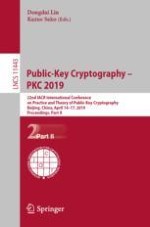2019 | OriginalPaper | Chapter
Non-zero Inner Product Encryption Schemes from Various Assumptions: LWE, DDH and DCR
Authors : Shuichi Katsumata, Shota Yamada
Published in: Public-Key Cryptography – PKC 2019
Publisher: Springer International Publishing
Activate our intelligent search to find suitable subject content or patents.
Select sections of text to find matching patents with Artificial Intelligence. powered by
Select sections of text to find additional relevant content using AI-assisted search. powered by
